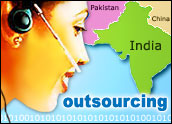
The trend of Americans and Canadians buying call centers in India is driven by the low cost of these facilities and by the speed with which buyers can begin using them. Thefirst article in this series in this series focuses on the advantages of buying a facility with less than 100 seats in Bangalore, primarily for outbound voice work.
In Part 2, we look at management issues and prices for buying an existing facility. Buying an existing facility is often motivated by the need to obtain experienced agents and to control the quality of service delivery.
Owning an Indian call center can provide a level of control that is hard to achieve in traditional outsourcing environments. Owners can use the call center to scale their own programs up and down, while using incumbent or additional outside programs as a cushion.
“The most critical factor for success of an acquisition is making sure the systems and processes of the acquired firm are interfaced with those of the parent,” said Mohit Malik of Noida-based Anoova Consulting.
“The planning and execution of the integration process makes all the difference,” he emphasized, “the difference between, say, getting married and having a successful marriage.”
Integration of a fully functional center with the processes of the acquiring firm may only take about a month. Two areas where control initially needs to be established are personnel and data.
Data Protection
Control over data can be a challenge at institutions that have not managed to do this successfully in the past. The theft or reuse of data is pervasive at many call centers, especially at those without established data protection and monitoring programs.
There are economic incentives encouraging the theft or reuse of lists of potential customers who can be called in telemarketing campaigns. Good lead lists can cost between 12 and 45 US cents per name and telephone number. Leads often go stale after six months or less.
A fresh new list provided by one client can easily make its way into another program. This can hurt the original program if leads begin to receive lots of calls from the same Indian call center attempting to sell a variety of goods and services.
At call centers owned by Westerners, control over lead lists can be higher than at small Indian merchant facilities. Western owners can also put the numbers of honey pots into their lead lists to enable them to spot list theft. If calls from India start rolling in to a U.S. telephone number maintained as a honey pot, this may indicate that a list has been stolen.
New non-disclosure agreements (NDAs) may need to be executed at an acquired call center. Many existing NDAs do a poor job of defining confidential information and go overboard by claiming that everything is confidential. Procedures need to be reviewed for storing confidential information, restricting access to it and, ultimately, purging it.
Incumbent Managers
The managing director (MD) of an 80 seat call center is often the principal investor. Malik recommends including a clause in the terms of sale requiring the MD of the acquired firm to continue employment with the call center for at least two years. Malik suggests that the CEO also be bound by a non-compete agreement that lasts for two or three years following the expiration of the employment contract.
The most powerful person at an 80-seat facility may not be the MD, but rather the operations manager. It is the manager who often brings in an established campaign and experienced agents who are loyal to that manager. This can enable managers to dictate business terms to the MD.
Management problems are responsible for about 80 percent of Indian call center failures. It is often assumed that the MD will either be ineffectual or incompetent in dealing with international customers and with operational issues. The manager will be the one tasked with those responsibilities — which, if performed badly, can doom a call center.
An individual who can recruit ten experienced agents to join a call center becomes a team leader. One who can bring in 25 to 40 agents can become a manager, particularly if a viable campaign to run is part of the package. The major asset of a manager is control over personnel who may be more loyal to an individual manager than to the MD or the firm that employs them.
The risk in buying a center is that one or more incumbent managers will jump over to other call centers, taking with them agents and business contracts. Kiran Upadhya, a Bangalore-based consultant with Uni Solutions, advises giving the incumbent managers generous pay increases, possibly in the 20 percent range, and seeking to retain them until the new owner has established control over the operation and, more importantly, control over the loyalties of the call center agents.
New Managers
New owners often need to put a savvy new manager in place immediately. The new manager will need to take over personnel functions from the incumbent manager or managers. Taking over payment and scheduling tasks can place a new manager in a position to gain the loyalty of agents and to lessen agents’ dependence on the incumbent manager.
Loyalty can be established by giving agents a 20 percent pay increase and by paying personnel on time. Timely payment of salaries and bonuses is a chronic issue in many businesses in India, even in Western-owned firms. Loyalty can be fostered if agents see that the new owners are committed to expanding or upgrading the facility.
Once the agents have established personal contact with the new manager and feel confident that they will be paid properly, then there will be less incentive to follow an incumbent manager to another facility. As a consequence, a facility’s new owners will be less threatened by the resignation or firing of an incumbent manager.
To replace incumbent managers, Upadhya recommends looking to promote from within. Creating internal career opportunities can encourage staff loyalty and reduce turnover.
Falling Prices
“Most facility sales occurring now are cash neutral,” said Upadhya, “with the new owners assuming the debts of the sellers.” Call center equipment quickly loses value, especially in a call center that is no longer operating. So buyers are targeting facilities that are operational and running some programs that can be continued after the transition.
In the first wave of Indian call center consolidations, which occurred in 2002, prices per seat were US$5,000, with some sales going as high as $8,000 per seat. Plummeting costs for new equipment have driven those prices down to less than $1,500 per seat in many cases today.
Commission rates for selling facilities range from 3 percent to 5 percent. The facilities that I had been brokering for sale in 2003 were owned by investors who had originally overpaid for new equipment. The owners were so reluctant to recognize how much their equipment had fallen in value that they rejected an offer of $500,000 for 350 seats. No better offer ever materialized.
Sellers need to put their facilities up for sale while the facilities are still operational and have a core team of experienced agents still in place. Original owners need to recognize that they will inevitably lose money in a sale, compared to their original investments and original expectations. A timely sale at a modest price is preferable to a delayed sale or to scrapping a facility’s components.
Buyers need to be ready to put a lot of energy into their new purchase, especially at first. Call center operations and a call center’s workplace culture can fall apart in less than a day.
Establishing a solid, friendly presence as soon as possible and instituting morale-building initiatives is crucial for preserving a buyer’s investment. Easing out the old managers while retaining non-managerial staff is often a delicate but necessary part of making a buyout successful.
Anthony Mitchell , an E-Commerce Times columnist, has beeninvolved with the Indian IT industry since 1987, specializing through InternationalStaff.net in offshore process migration, call center program management, turnkey software development and help desk management.
















































